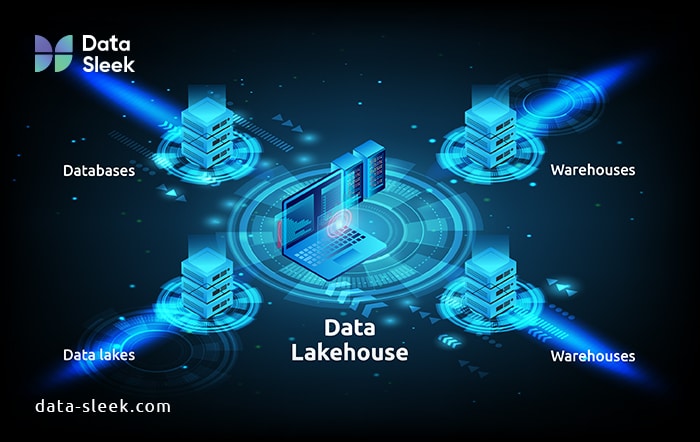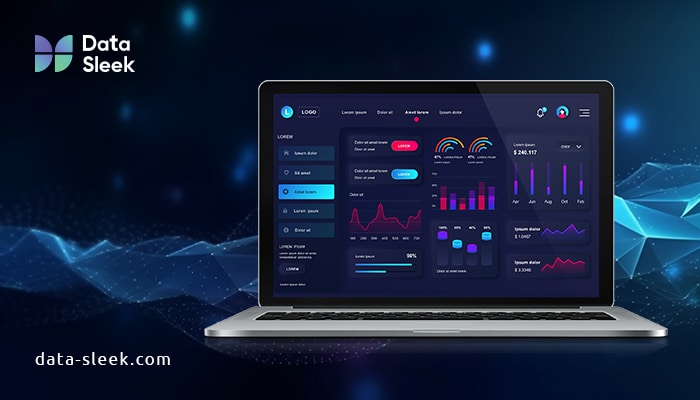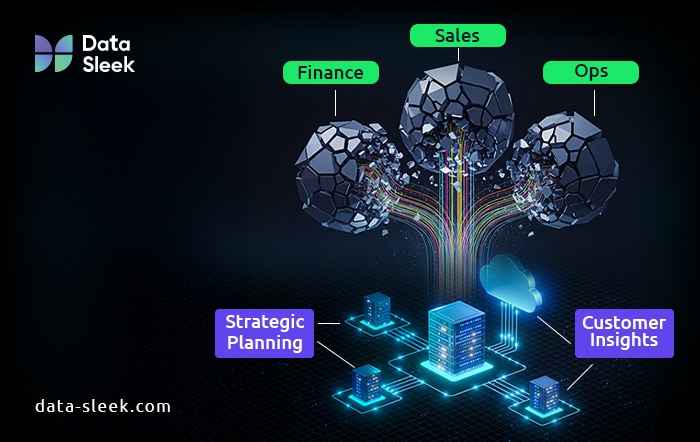Ensuring the proper methods for data storage while keeping it fit for purpose has gone from a convenience to a necessity, particularly when dealing with big data solutions. However, you might be wondering about the differences between modern data architecture, like a Data Lake vs Data Warehouse, and how operational databases factor in. Discover the differences and capabilities for data lakes, data warehouses, operations databases, and even data lakehouses, and how they can help inform your business intelligence foundation.
What is a Data Lake, Data Warehouse, and Database?
Although these terms might seem difficult to take in at first glance, there are several fundamental reasons to understand the difference between a Data Lake vs Data Warehouse, and operational databases, and how to effectively utilize them.
According to IBM, Data lakes are economical means of containing raw data produced by your business in several forms, including semi-structured, structured and and unstructured. This historical data can be freely added to as needed, and is especially useful for machine learning, predictive analytics, and extracting insights from big data, including unforeseen errors.

While data warehouses also retain large amounts of historical data, they are designed to store anything from raw data to data that has been aggregated, cleansed, curated, and filtered. Data warehouses are ideal for handling both semi-structured and structured data, as well as regularly performing Extract, Transform, and Load (ETL) processes to provide reports and dashboards with fresh, accurate data. In a way, you could consider data warehouses to be large, extremely specialized databases that provide your company with accurate and current business intelligence (BI).
The word “database” is ubiquitous in technology, and for good reason, given its vital relationship to storing app data. Operational databases allow for processes including:
- Real-time data processing.
- Utilizing advanced security features to protect data.
- Maintaining transactional records.
- Managing mobile apps.
- Providing full-text search capabilities.
- Offering APIs for easy queries.
In summary:
- A database stores current data needed to operate a given app.
- A data warehouse, on the other hand, holds current and historical data from multiple systems in predefined and fixed schemas. This structure enables business analysts and data scientists to review data with ease.
- In contrast, a data lake stores current and historical data in raw form. This allows business analysts and data scientists to analyze the data effectively as well.
What constitutes the best choice among these data storage methods depends on your organization’s specific requirements and goals.
Data Lake vs Data Warehouse: Key Differences and When to Use Each
Data Types and Structure
All three data storage solutions have their strengths and weaknesses, which impact your organization’s ability to prepare for and conduct analysis. When it comes to Data Lake vs Data Warehouse vs Databases, we can draw these conclusions:
- Data Warehouses excel in speed and structured analytics.
- Data Lakes offer flexibility for raw data exploration, but they require more preparatory work to be effective.
- Transactional databases are instrumental in real-time operational analytics but have limited use for broad analytical applications.
Selecting the best data storage solution will have a genuine impact on the efficacy and efficiency of the analytics processes in place for your business.
| Database | Data Lake | Data Warehouse | Data Lakehouse | |
| Computational Tasks | Operational and Transactional Analytics. | Analytical Data. | Analytical Data. | Real-Time Analytics. |
| Types of Data | Structured or semi-structured data. | Structured, semi-structured, and/or unstructured data. | Structured and/or semi-structured data. | Structured, semi-structured, and unstructured data. |
| Adaptability of Schemas | Can provide rigid and flexible schema, depending on the type of database. | No schema definition required for ingesting data (schema takes effect on read). | Pre-defined and fixed schema definition for ingest (schema takes effect on write and read) | Allows for the creation of custom data schemas for data control. |
| Timeliness of Data | Real-time. | May not provide current data, depending on the frequency of ETL processes. | May not provide current data, depending on the frequency of ETL processes. | Supports real-time analytics via fast data ingestion and processing. |
| Who Benefits? | App developers. | App developers, business analysts, and data scientists. | Business analysts and data scientists. | Data scientists, data analysts, and business intelligence professionals. |
| Advantages | Enhanced query speeds when storing and updating data. | Superior data storage enhances ingestion of raw data, which enables the creation of data schemas, making data management simple for your business by separating storage from computing. | Having a fixed schema in place allows easy data manipulation for business analysts. | Simplified data management, enhanced governance, and supporting diverse workloads. |
| Disadvantages | Analytics capabilities may be limited. | More effort required to prepare/organize data for use. | Hard to adapt and design schemas. Increased computing might cause unnecessary scaling of data storage, given their close relationship. | Complex management required, limitations on query performance limitations, and needing specialized experts. |
Speed and Accessibility
- Data Lakes offer adaptability when handling both real-time and batch queries, making them suitable for big data solutions, machine learning, and addressing issues related to unstructured data.
- Data Warehouses deal with structured data, often providing a business with solid reporting and analytics capable of handling batch queries and increasingly real-time processes.
- Databases are already optimized for immediately handling transactions and making queries in real-time. These capabilities grant excellent options to businesses in need of quick access to structured data.
Cost and Scalability
- Data lakes offer excellent long-term scalability for vast amounts of data at lower storage costs but can incur high processing costs for complex analytics.
- Data warehouses offer solid performance for structured data, providing a cost-effective real-time analytics infrastructure; however, scaling can be costly.
- Traditional databases excel at transaction handling but may face higher costs as demand and data volumes grow.

Tools and Technologies
- Data lakes provide cost-effective storage and the flexibility to perform simultaneous analysis of multiple, varied data types. Commonly used platforms include Amazon S3 and Databricks for data monitoring and analysis.
- Data warehouses excel when handling structured data analysis and reporting, particularly for real-time insights. Frequently used tools include Amazon Redshift, Azure Synapse Analytics, and Snowflake, which are well-suited for handling large datasets.
- Databases are best suited for apps that require efficient transaction processing and maintain data integrity. Popular data analytics platforms for databases include MySQL, PostgreSQL, and Microsoft SQL Server.
Architecting for Success: Building Your Optimal Modern Data Ecosystem (Integration & Strategy)
The Integrated Approach: Data Lakehouse & Beyond
A data lakehouse provides a single platform where both raw and refined data can coexist. This unified architecture eliminates the need to move data between systems (from lake to warehouse), reducing data duplication, integration costs, and maintenance burdens. This structure enables consistent performance for both advanced analytics and traditional BI without sacrificing flexibility.

Combined with high-performance engines like Apache Spark, Photon, or Trino, lakehouses support both interactive queries and batch processing. This allows teams to access analytics faster, without the performance tradeoffs often seen in traditional data lakes vs data warehouses. Businesses can explore large, diverse datasets in real-time without building duplicate pipelines or moving data between systems.
Achieving Real-time Analytics Infrastructure
Combining data lakehouse technology with comprehensive analytics platforms that are supported by streaming technologies, your company can create a robust, real-time analytics infrastructure. This combination enables immediate insights and improves the data lifecycle efficiency, allowing your organization to respond more quickly and strategically.
Enterprise-Level Data Integration: Breaking Down Silos
Robust data integration strategies are crucial for establishing a Unified Data View, fostering a data-driven culture that enhances strategic planning, operational efficiency, and overall competitiveness within your enterprise. Notable advantages include:
- Better Agility and Responsiveness.
- Better Data Quality.
- Compliance and other Risk Management.
- Eliminating Siloed Data.
- Data-driven Customer Insights.
- Improved Informed Decision Making.
Driving ROI and Mitigating Risks: Data Management Best Practices
The Criticality of Data Governance
Data governance issues are genuine challenges for any business seeking to maintain a cohesive and effective data ecosystem, which can complicate the decision between Data Lake vs Data Warehouse. Robust data governance frameworks are crucial for addressing said challenges while also ensuring that your data remains a valuable asset across your organization. A strong data governance framework provides precise guidelines, roles, and accountability for managing the lifecycle of your corporate data. This framework is vital for several reasons:
- Achieving Compliance.
- Driving Accountability.
- Enhancing Security.
- Ensuring Data Quality.
- Facilitating Collaboration.
Tackling data governance challenges with a robust framework is essential for ensuring data quality, security, and compliance with regulatory bodies, possibly for multiple countries. Organizations that prioritize efficient data governance will improve their operational capabilities and positions themselves for long term success in the current data-driven landscape.
Ensuring Data Quality: The Foundation of Reliable Insights
The value of any Big Data solution is inextricably tied to data quality and data management consulting services. By ensuring the quality of their data, organizations must implement effective data cleansing, validation, and maintenance processes.
Data Cleansing: Identifying and eliminating problems and inconsistencies in the datasets, like removing duplicate data, fixing inaccuracies, and standardizing formats to ensure that data is reliable and usable.
Data Validation: The verification that any data meets specific criteria before it is used in analysis, like checking for accuracy, completeness, and relevance, which helps prevent poor decisions based on flawed information.
Data Maintenance: The ongoing process of managing data to ensure its integrity over time, including regular updates, monitoring, and archiving of data, as well as addressing any new quality issues that may arise.

These steps are crucial for maintaining data ecosystems that optimize the effectiveness of Big Data solutions in driving business insights and informed decisions for your enterprise.
The Strategic Advantage of Cloud Data Solutions
Cloud Data Solutions offers several advantages that significantly improve scalability, cost-effectiveness, and agility when developing your Modern Data Architecture. The combination of scalability, cost-effectiveness, and agility makes cloud data solutions a compelling choice for organizations seeking to build a Modern Data Architecture. By leveraging the advantages granted by Cloud Data Solutions, companies can improve operational efficiency, respond effectively to market changes, and drive business growth. Looking to build your optimal Data Ecosystem? Book a free consultation with a data expert.
Your Path to an Optimized Data Strategy: Next Steps for Executive Leaders
Developing the best data strategy for your business does not lie in selecting a single technology; instead, it involves effectively integrating appropriate combinations of technologies engineered to fit your specific business’s requirements. Focusing on long-term Data Ecosystem Optimization is vital, especially when managing sustained growth and fostering innovations. This holistic approach helps businesses adapt and thrive in an ever-evolving landscape.
Build Your Optimal Data Ecosystem: Book a Free Consultation with a Data Expert.
FAQs
Can a business utilize both a data lake and a data warehouse?
In short, yes. Using both data lakes and data warehouses enables a company to leverage the benefits of each system. Data lakes take in large and varied datasets for exploration and experimentation. Data warehouses provide accurate, curated data for your business reports and to aid in decision-making. This combination enables the development of a comprehensive data strategy that can adapt to various analytical needs, facilitating both operational and strategic insights.
When should I use a data lake?
A data lake is ideal for handling diverse and vast amounts of data that require exploration and analysis, particularly when cost and flexibility are significant factors.
Is a data lake cheaper than a warehouse?
Data lakes are less expensive than data warehouses, particularly when handling lots of diverse data. Data lakes use less costly storage options, providing improved flexibility for data storage and management. Data lakes utilize multiple data formats without requiring upfront schema definitions, which also lowers expenses for data processing and storage. However, whether a data lake is the more cost-effective option for a specific organization can depend on the particular use case and requirements for data processing and analytics.
When should I choose a data lake over a database for my project?
Factors to consider when selecting data lakes over databases include diverse data, large volumes of data, data processing, analytics capabilities, and overall cost. If your business could benefit from structured data, transactional processes, or strong consistency and reliability, traditional databases may be a better option.
Can I combine the use of lakes and databases in my data architecture?
Using both data lakes and databases allows you to ensure that your business data architecture supports many data types and use cases. By combining both resources, it allows for superior insights and efficient data management for your business. This combination enables your business to leverage the scalability of data lakes while maintaining structured query capabilities and traditional database performance.
How do data lakes handle unstructured versus structured data differently from databases?
Databases excel in managing structured data utilizing explicit schemas and efficient querying. Data lakes provide the necessary flexibility to store and analyze all types of data, accommodating the diverse needs of modern data analytics.


